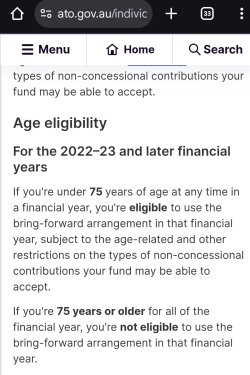- Joined
- Jul 18, 2008
- Posts
- 3,737
Yes they open a new separate fund, to recontribute to.Do you recontrivute to a separate super fund to keep all the newly converted non concessional funds separate from the existing concessional funds?.
Yes they open a new separate fund, to recontribute to.Do you recontrivute to a separate super fund to keep all the newly converted non concessional funds separate from the existing concessional funds?.
Thanks. So it's based on the current percentage of each super and not a given ATO formula. I knew we couldn't specify from where.That's my understanding You can't specify which funds to take out.
If % of concessional in accumulation is 70% then when you withdraw, 70% will be concessional and 30% will be non concessional.
Yes of course. But I like to know exactly what to ask first.Perhaps it's time to sit down with a qualified and independent advisor?
$360k now (or $120k p.a.).two rounds of $300K
So I have five years then. I can make two rounds of $300K so $600000. And I'll need to set up another pension fund to put the funds back in. Some can stay in the accumulation account which we both kept as well as still working.
But thinking again, when the funds are withdrawn they aren't all taken from the taxed part, are they..
So, if I turn 75 at the end of the second round (June) it's still ok to do it that year? Although if I get my act together I can do it the year before.
It will continue to index, but not change until the Government specify it. They want to keep the numbers nice and round.$360k now (or $120k p.a.).
Given recontributing to your initial fund will always reduce the concessional percentage for next withdrawal, wouldn’t you always be better off putting into a new fund (not impacting this percentage)? You could always recombine later.The amounts withdrawn are done in proportion of the concessional and non-concessional mix in the current fund. People need to calculate whether it's best to recontribute to the initial fund, or set up a new super fund for the W&R amount (where the recontributed money, assuming you don't claim a tax deduction, wil be non-concessional and free of tax to the person, their spouse or any eventual beneficiaries).
I think a better strategy would be to leave the bring forward provision until your last year of contributing. Effectively allows you 7 years of contributions
Given recontributing to your initial fund will always reduce the concessional percentage for next withdrawal, wouldn’t you always be better off putting into a new fund (not impacting this percentage)? You could always recombine later.
"75" is at the latest June 30 of the financial year where you click over to 75 yrs?
Age 72 - contribute 3x120 for age 72,73,74.
Age 75 - contribute 3x120?. I thought can only do 1x$120
Well everything depends on the person, their situation (ability to contribute or re-contribute), their total super balances and other items:I think a better strategy would be to leave the bring forward provision until your last year of contributing. Effectively allows you 7 years of contributions.
So salary sacrifice comes into play as well to determine the limit.
Yeah of course, I was only looking at the maxing contributions part of this particular equation!Well everything depends on the person, their situation (ability to contribute or re-contribute), their total super balances and other items:
Non-concessional contributions cap | Australian Taxation Office
Keep track of your non-concessional (after-tax) contributions, which are not taxed unless you exceed the cap.www.ato.gov.au
You can actually contribute up to 28 days after June 30 of the year you turn 75."75" is at the latest June 30 of the financial year where you click over to 75 yrs?
The amount of non concessional contribution /recontribution or other voluntary contribution you can make including salary sacrifice depends on whether there is space between the TSB and the general transfer balance cap. The transfer balance cap is $2M for this financial yearSo salary sacrifice comes into play as well to determine the limit.
Sure but my question is more the ability to transfer under the bring forward arrangements at 75 if TSB allowsSearch for the below section in the link QF WP provided,
My reading of the ato site below is yes but doesn't seem logicalSure but my question is more the ability to transfer under the bring forward arrangements at 75 if TSB allows
If $360,000 is available in the TSB you comment suggests I can contribute $360,000 at age 75 (assume I brought forward contributions of age 73 and 74 where I contributed $360,000 at age 72) . Is that correct

That's my understanding as well. If no personal contributions are available after age 75, logically there is nothing to bring forwardbut doesn't seem logical

